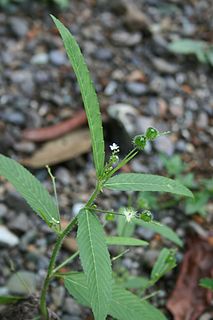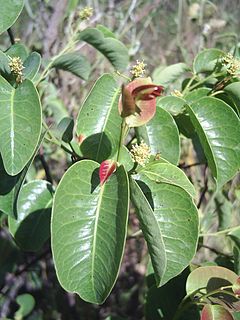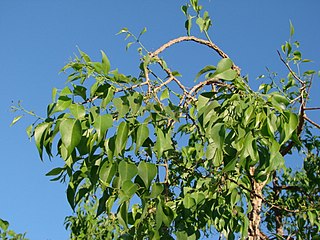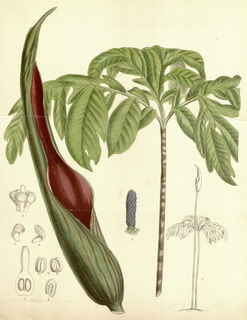
Amanoa is a genus from the family Phyllanthaceae first described as a genus in 1775. It is native to South America, Central America, the West Indies, and tropical Africa.

Sebastiania is a genus of flowering plants in the family Euphorbiaceae first described in 1821. It is native to North and South America from Arizona and the West Indies south to Uruguay.

Pera is a genus of the flowering plant family Peraceae, first described as a genus in 1784. It is native to tropical America, from southern Mexico and the West Indies south as far as Paraguay.

Cnidoscolus is a plant genus of the family Euphorbiaceae first described as a genus in 1827. The group is widespread across much of North and South America, including the West Indies.
Adenophaedra is a plant genus of the family Euphorbiaceae first described as a genus in 1874. It is native to tropical regions of South America and Central America.
- Adenophaedra cearensis Secco - Ceará
- Adenophaedra grandifolia (Klotzsch) Müll.Arg. - Costa Rica, Panama, Colombia, Venezuela, Guyana, French Guiana, Ecuador, Peru, NW Brazil
- Adenophaedra megaphylla (Mull.Arg.) Mull.Arg. - Colombia, Ecuador, Peru, Suriname, E Brazil
Bernardia is a plant genus of the family Euphorbiaceae first described for modern science as a genus in 1754. It is native to North and South America, as well as the West Indies.
Caryodendron is a plant genus of the family Euphorbiaceae first described as a genus in 1860. The genus includes C. orinocense, known as the Inchi tree or Tacay nut. It is native to Central America and South America.
- Caryodendron amazonicumDucke - Amazonas in Brazil
- Caryodendron angustifoliumStandl. - Costa Rica, Panama, Colombia
- Caryodendron janeirenseMüll.Arg. - Rio de Janeiro
- Caryodendron orinocenseH.Karst - Colombia, Venezuela, Ecuador

Caperonia is a genus of plants of the family Euphorbiaceae first described as a genus in 1825. The genus is native to tropical and subtropical America and Africa.

Ditaxis is a plant genus of the family Euphorbiaceae first described as a genus in 1824. Its name comes from Greek dis ("two") and taxis ("rank"), referring to the stamens which are in two whorls. The genus is widespread across much of the Western Hemisphere from the southern United States to Uruguay.
Philyra is a plant genus of the family Euphorbiaceae first described as a genus in 1841. It contains only one known species, Philyra brasiliensis, native to Brazil, Paraguay, and northeastern Argentina.

Dalechampia is a genus of plant of the family Euphorbiaceae and of the monogeneric subtribe Dalechampiinae. It is widespread across lowland tropical areas primarily in the Americas with smaller numbers of species in Africa, Madagascar, and southern Asia. Additional new species are still being described and several are very rare and at risk of extinction.

Stillingia is a plant genus of the family Euphorbiaceae, first described for modern science as a genus in 1767. The genus is native to Latin America, the southern United States, and various islands in the Pacific and Indian Oceans. Toothleaf is a common name for plants in this genus.

Gymnanthes is a genus of flowering plants in the spurge family, Euphorbiaceae first described as a genus in 1788. It is found primarily in the warmer parts of the Western Hemisphere, but with some species in central Africa and southwestern Southeast Asia.

Mabea is a plant genus of the family Euphorbiaceae first described in 1775. It is native to Central and South America as well as Mexico and Trinidad.

Maprounea is a plant genus of the family Euphorbiaceae first named as a genus in 1775. It is native to tropical Africa, Trinidad, and tropical Central and South America.
- Maprounea africana - W + C + S Africa, from Benin to Zimbabwe
- Maprounea amazonica - Colombia, Venezuela, N Brazil
- Maprounea brasiliensis - Brazil, Paraguay, Bolivia
- Maprounea guianensis - Trinidad, Panama, Colombia, Venezuela, French Guiana, Suriname, Guyana, Brazil, Peru, Ecuador, Bolivia, Paraguay
- Maprounea membranacea - Nigeria, Cameroon, Gabon, Equatorial Guinea, Cabinda, Central African Republic, Congo, Zaire

Microstachys is a genus of plants in the Euphorbiaceae first described as a genus in 1824. It is native to tropical Africa, southern Asia, Australia, Papuasia, Mesoamerica, the West Indies, and South America.
Discocarpus is a genus of the plant family Phyllanthaceae first described as a genus in 1841. It is native to northern South America.
- Discocarpus essequeboensisKlotzsch - Brazil, Venezuela (Amazonas), Guyana, Suriname, French Guiana
- Discocarpus gentryiS.M.Hayden - S Venezuela (Amazonas), Peru (Loreto), N Brazil
- Discocarpus pedicellatusFiaschi & Cordeiro - State of Bahia in Brazil
- Discocarpus spruceanusMüll.Arg. - Venezuela (Amazonas), Brazil, Suriname (Sipaliwini), Bolivia

Agonandra is a genus of plants in the family Opiliaceae described as a genus in 1862.

Dracontium is a genus of flowering plants similar to those of Amorphophallus. Unlike Amorphophallus which is found in the Old World, this genus has a New World distribution and is native to South America, Central America, southern Mexico, and the West Indies.

Pausandra is a plant genus of the family Euphorbiaceae first described in 1870. It is native to Central America and South America.
- Pausandra fordiiSecco - Amapá, French Guiana
- Pausandra hirsutaLanj. - Peru, Brazil, Bolivia (Pando), Colombia (Amazonas)
- Pausandra macropetalaDucke - Brazil, Peru (Loreto), Venezuela (Amazonas)
- Pausandra macrostachyaDucke - Pará
- Pausandra martiniBaill. - French Guiana, Suriname, Guyana, Colombia, Venezuela, Peru, Brazil
- Pausandra megalophyllaMüll.Arg. - Rio de Janeiro
- Pausandra morisiana(Casar.) Radlk. - Brazil
- Pausandra trianae(Müll.Arg.) Baill. - widespread from Honduras to Bolivia














